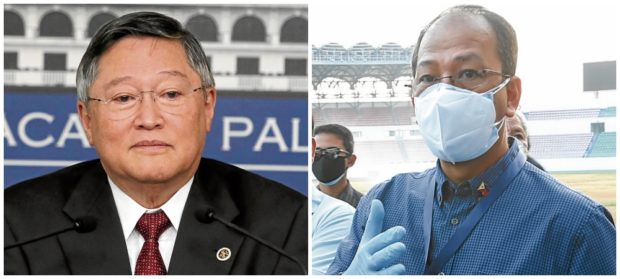
[ad_1]

Carlos Domínguez III (left) and Carlito Galvez Jr.
The government is considering borrowing up to $ 9 billion (P433.3 billion) from the World Bank to help finance the country’s purchase of a potential COVID-19 vaccine, as it begins negotiations with a leading pharmaceutical company for at least 3 million doses of the drug. to be given mainly to healthcare workers.
Carlito Galvez Jr., head of the national COVID-19 task force, said on Monday that the country would have to enter into “multilateral commitments with our credit partners,” such as the World Bank and the Asian Development Bank, since the allocated budget for the Vaccine can not be used to buy the drug in advance.
Gálvez said that Finance Secretary Carlos Domínguez III was already working on how much the government could borrow from the World Bank for the early purchase of the vaccine.
“A lot of funds” The government has set aside P10 billion and can get an additional P8 billion for vaccines, Galvez said. This is separate from the P25 billion reserve fund for the COVID-19 response under the Bayanihan to Recover as One Act, he said.
“About the $ 5 to $ 9 billion that can be credited to our account, we have already allocated a large amount of funds. That is why the President is very confident that we already have the money, and will still get more, for the vaccine, “said Gálvez.
In September, the Department of Health (DOH) said some vaccine manufacturers required an advance payment for the Philippines to secure supplies. However, the procurement law prohibits agencies from paying for items ordered in advance.
Galvez said the government planned to buy 50 million initial doses of a vaccine for 25 million Filipinos, mostly healthcare workers and the elderly.
Earlier, British-Swedish drug maker AstraZeneca announced that if its large-scale phase 3 clinical trials were successful, it would ramp up the manufacture of its vaccine, which could be on the market in January next year.
Galvez said the country’s panel of vaccine experts gave AstraZeneca a “good assessment,” but did not provide details.
However, he said the government had already met three times with AstraZeneca and had been assured that poor countries would access the vaccine and it would be sold at cost.
Of all the vaccines that have been evaluated by the panel so far, AstraZeneca’s is the cheapest at $ 5 per dose.
“Right now our negotiations [with AstraZeneca] seek to access at least 3 to 5 million [doses]. But we are working to [raise it to] at least 10 million doses for our [medical] top of the line, ”he said.
In early 2022, but Gálvez sought to moderate expectations, saying that despite these developments, there was a chance that most of the supplies the country needs will not arrive until early 2022.
“From this moment on, if we can close the negotiations during this year, there may be hope. Realistically, we can get 10 to 15 million [doses] between May and July, ”he said.
Presidential spokesman Harry Roque told a news conference on Monday that the government expected to be ready by March with its procurement processes, storage arrangements and early distribution plans for the vaccine.
Roque said the plans were based on a schedule presented by Gálvez.
He said the safety and efficacy of the vaccine must first be confirmed by the Food and Drug Administration and a panel of vaccine experts.
A decision must also be made whether to opt for a single-dose or two-dose vaccine, as this would determine the type of cold storage to prepare.
A decision must also be made whether the vaccine should be obtained from a single source or from multiple sources, Roque said.
He said that the Department of Health (DOH), along with national and local governments, would be in charge of implementing the vaccination program at the national level.
New infections: On Monday, the DOH recorded 2,058 additional coronavirus infections, bringing the total number of confirmed COVID-19 cases to 398,449.
Rizal Province reported the highest number of new infections, 103, followed by Davao City (81), Maguindanao (81), Quezon City (77), and Cavite (76).
Another 182 patients had recovered, bringing the total number of COVID-19 survivors to 361,784, the DOH said. The death toll, however, rose to 7,647 when 108 patients succumbed to the severe respiratory illness.
Recoveries and deaths left the country with 29,018 active cases, or 7.3 percent of the total, of which 82.7 percent were mild, 9.4 percent asymptomatic, 2.8 percent severe, and 5 percent critical. – WITH A REPORT FROM JEROME ANING INQ
Read next
Subscribe to INQUIRER PLUS to get access to The Philippine Daily Inquirer and more than 70 other titles, share up to 5 gadgets, listen to the news, download from 4am and share articles on social media. Call 896 6000.
[ad_2]

